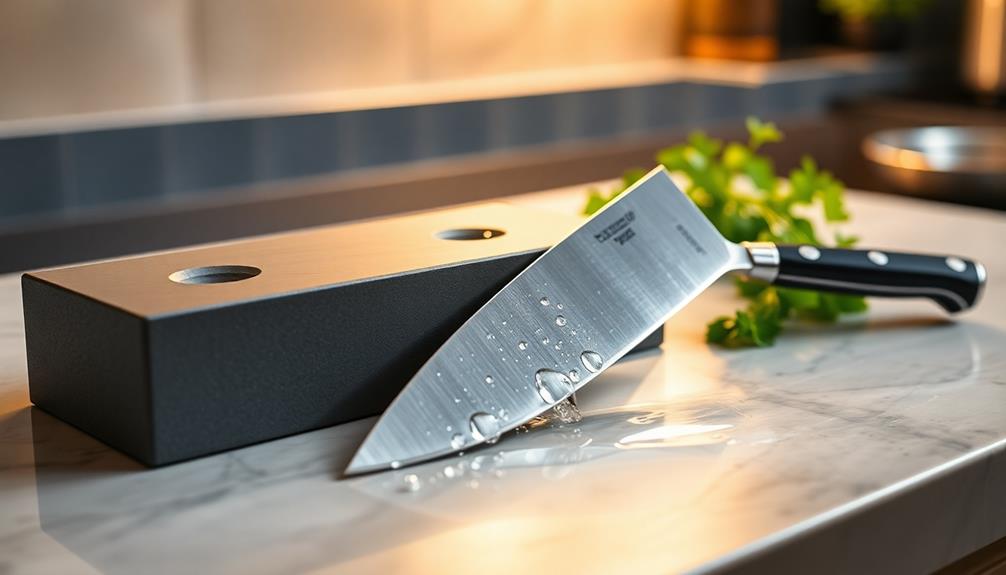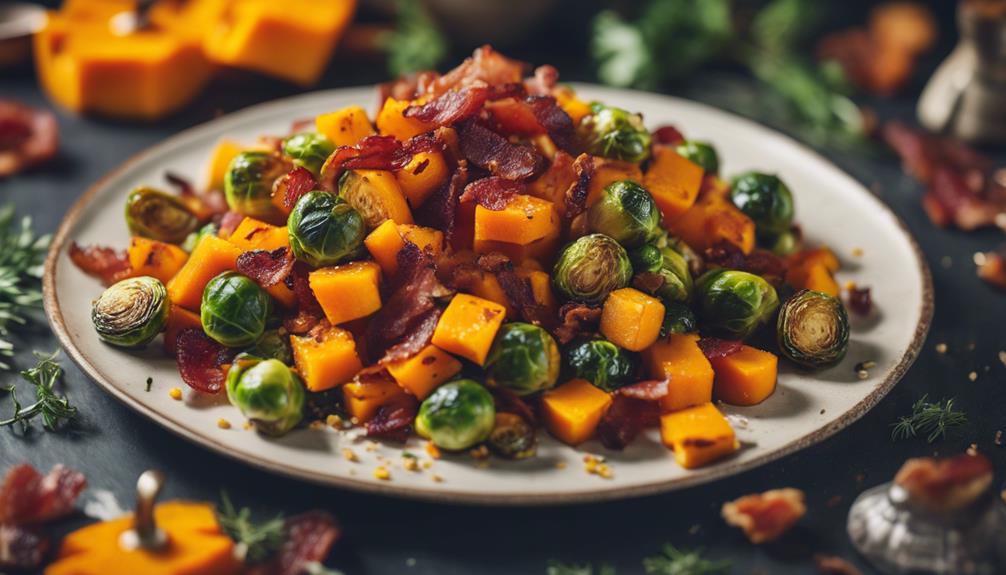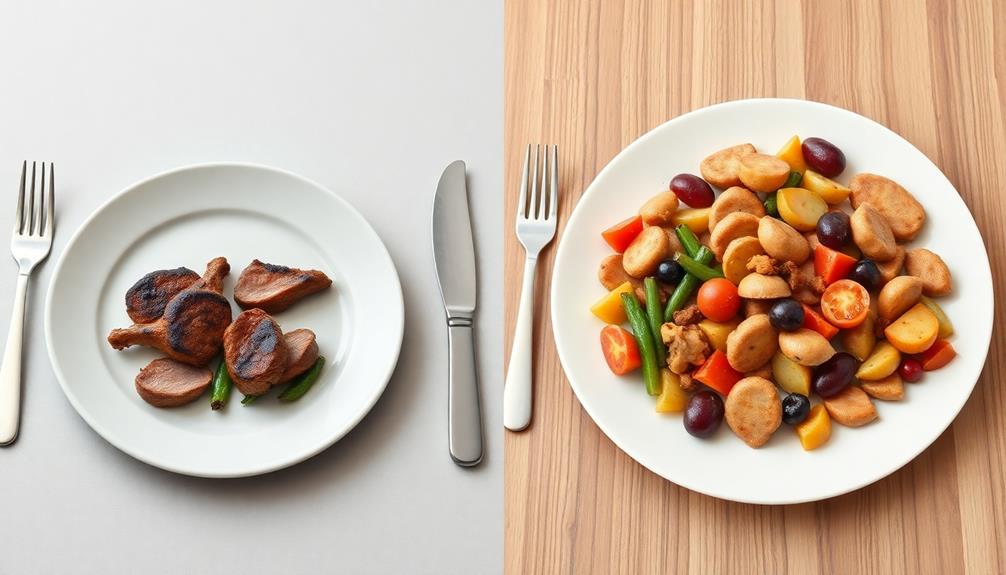To sharpen knives like a professional chef, start by evaluating your blade's dullness. Use a manual sharpener or whetstone, pulling the knife through the coarsest slot 3-6 times before refining it. For even precision, consider an electric sharpener. Regularly hone your knives to maintain sharpness and inspect them under light for any micro-chipping. Always clean and dry your blades after use to prevent rust. Choosing the right technique and tool is crucial depending on your knife type. If you want to elevate your knife skills further, there's plenty more to discover about maintaining their edge and performance.
Key Takeaways
- Choose the right sharpening tool: use whetstones for high-carbon steel knives and manual sharpeners for quick maintenance.
- Maintain a consistent angle of 15 to 20 degrees while sharpening to achieve optimal edge precision.
- Regularly inspect knife edges under light to identify dullness or micro-chipping before each use.
- Hone knives before each use with honing steel to realign the blade and prolong sharpness.
- Clean and dry knives immediately after use to prevent corrosion and ensure long-lasting performance.
Essential Knife Sharpening Tools
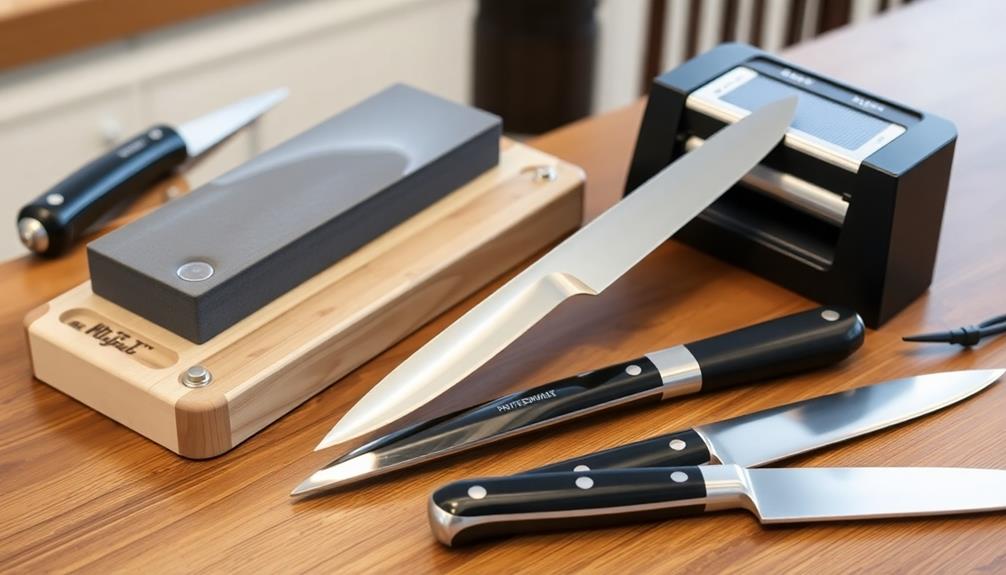
When it comes to keeping your kitchen knives in top shape, having the right sharpening tools is essential. Just like using fresh ingredients is key in farm-to-table cooking, having the right tools can elevate your culinary experience.
You've got several options to take into account, each suited for different needs. Manual sharpeners like the Mueller 4 in 1 are perfect for home use, offering multiple slots for various sharpening requirements. The Tumbler Rolling Sharpener provides unique angle settings, making it user-friendly.
If you prefer a more advanced option, electric sharpeners like the ChefsChoice 1520 deliver precision for both flat and serrated blades. They're great for beginners who want a foolproof experience.
For those who enjoy a hands-on approach, traditional whetstones like the King Whetstone Starter Set allow for a customizable sharpening experience. With grits ranging from 1,000 for shaping to 6,000 for refinement, you'll gain skill over time.
Don't forget about honing steels, which are vital for regular maintenance. They help keep knife edges aligned and prolong sharpness between your more intensive sharpening sessions.
No matter which tool you choose, make sure you have a stable cutting board to support your work and protect your knives as you sharpen them.
Step-by-Step Sharpening Techniques
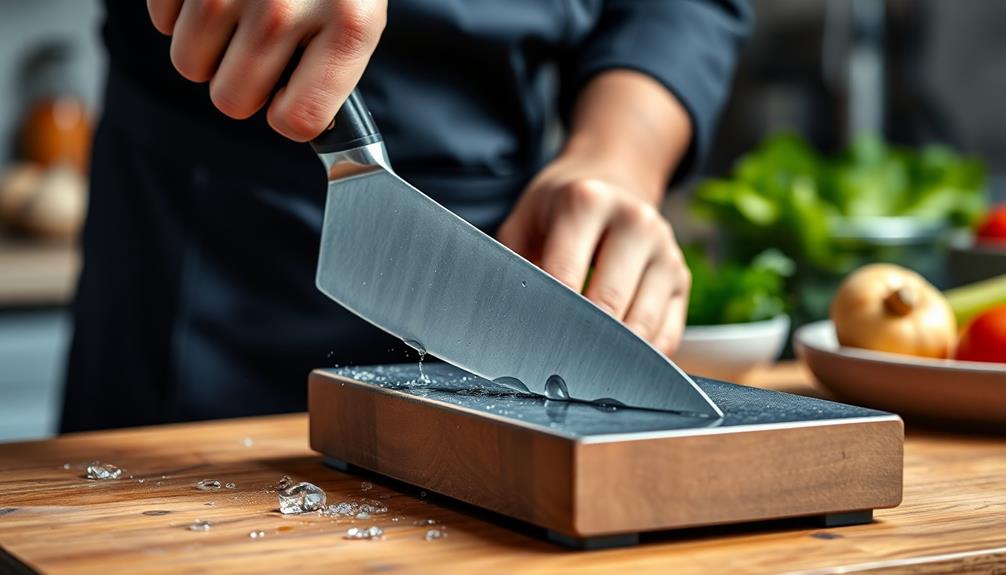
To sharpen your knives effectively, start by evaluating how dull the blade is, as this will guide your choice of sharpening method.
If you prefer manual sharpeners, begin with the coarsest slot. Pull the knife through steadily 3-6 times, then switch to finer slots to refine the edge.
For electric sharpeners, follow the instruction manual closely. Pull the knife through the coarse slot at an even speed, then repeat on the other side before moving on to the finer slots. A sharp knife is essential for preparing ingredients, whether you're slicing pork belly for a rich Red-Braised Pork Belly or cutting vegetables for a revitalizing cold noodle dish.
If you're using a whetstone, soak it in water for an hour first. Maintain a consistent angle while pulling the blade across the stone, flipping it to sharpen the opposite side, and rinse the blade periodically to remove metal filings.
Regardless of the method you choose, regularly hone your knife before each use to keep it sharp. Inspect the edge under light to spot any micro-chipping or dullness that could indicate the need for sharpening.
Maintaining Kitchen Knife Sharpness
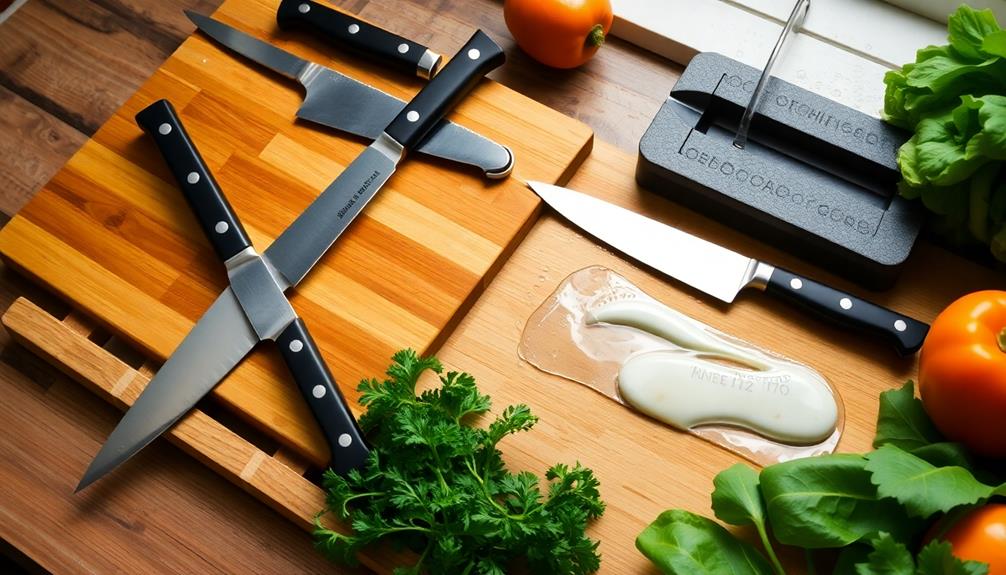
Maintaining the sharpness of your kitchen knives is just as important as the sharpening techniques you use. Regularly inspect your knife edges under light to check for micro-chipping or dullness. Depending on how often you use your knives, it might be time to sharpen them 1-2 times a year or even monthly.
Incorporating skills from culinary traditions can enhance your knife techniques, just as Brazilian cuisine highlights the importance of using the right tools for the right dishes. Before each use, grab a honing steel to realign the blade edge. This quick action helps prolong sharpness and reduces the need for frequent sharpening.
When it's time to sharpen, choose the right tool: manual sharpeners work well for basic maintenance, while whetstones offer precise control and customization of your blade shape.
After using your knives, clean and dry them immediately to prevent corrosion, which can seriously affect sharpness and longevity.
Finally, store your knives properly in a knife block, on a magnetic strip, or in sheaths. Proper storage avoids dulling and accidental damage, ensuring your knives remain in peak condition for every culinary task. Many people don’t realize the importance of proper knife storage, but it can make a big difference in the longevity of your knives. By investing in a good quality knife block or magnetic strip, you can also ensure that your knives are easily accessible and organized in your kitchen. So, treat yourself to the gift of well-maintained knives – it’s a much better investment than any spooky Halloween treat.
With these practices, you'll keep your kitchen knives sharp and ready for action.
Special Considerations for Knife Types
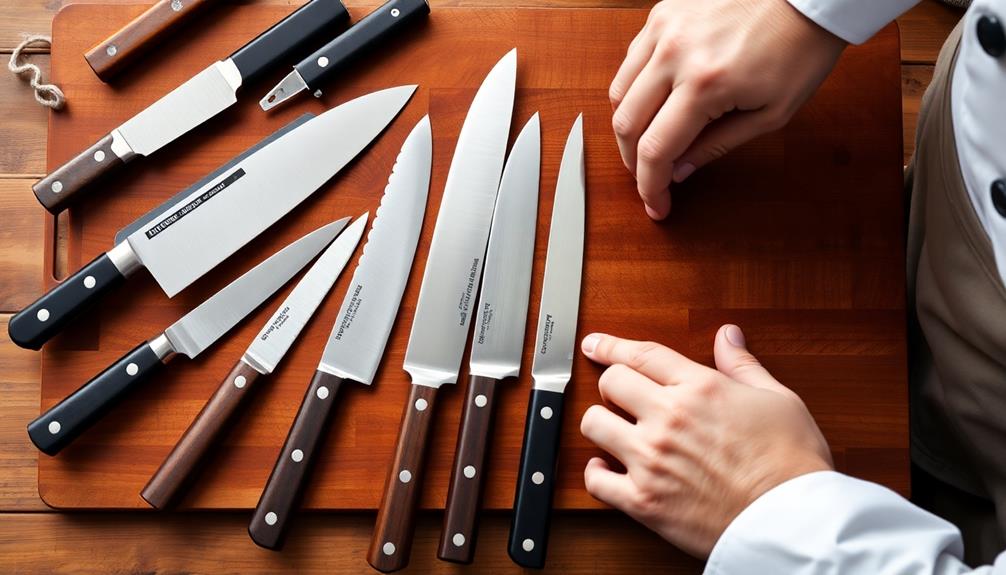
When it comes to sharpening different types of knives, you need to take into account their unique features.
For instance, understanding the culinary traditions from around the world can enhance your appreciation for various knife styles used in diverse cuisines.
Ceramic knives, for example, require specific tools and techniques to prevent chipping, while specialty blades like serrated knives call for tailored methods.
Knowing how to maintain and sharpen each type will help you keep your entire collection in top shape.
Ceramic Knife Sharpening Tips
Sharpening ceramic knives requires a different approach than sharpening traditional steel blades due to their unique properties. Because ceramic knives are made from hard materials, you need to use a whetstone or diamond stone for effective sharpening. Traditional tools simply won't cut it.
To prevent chipping or snapping, always use two hands for stability during the sharpening process. For those who enjoy preparing Indonesian dishes, having a sharp knife is essential for slicing ingredients like fresh herbs or crafting intricate presentations, much like the colorful layers of Layered Cake.
Focus on maintaining the blade angle, ideally between 15 to 20 degrees. Unlike steel knives, don't rely on burr formation. Instead, keep that angle consistent for an effective edge.
When it comes to grit, start with finer grits—1,000 grit or higher works best to achieve a polished edge. This guarantees your knife performs at its best.
Inspect your knife regularly and handle it with care while sharpening. Ceramic knives tend to retain their sharpness longer than steel ones, so a little bit of attention to detail during sharpening can prolong their life considerably.
Maintaining Specialty Knife Blades
Specialty knife blades demand particular care to guarantee peak performance and longevity. When it comes to ceramic knives, remember they're hard and brittle, which makes them prone to chipping. Always use a whetstone or diamond stone for sharpening, and stabilize the knife with both hands to maintain the proper angle—this method is essential since you won't rely on burr formation.
Just like crafting a delicate Dorayaki (Red Bean Pancake) requires precision, so does sharpening these knives.
For high-end Japanese knives, opt for a traditional water whetstone. A dual-grit setup, like 1,000/6,000, is necessary for both shaping and refining the edge. If you're working with specialty serrated knives, use a serrated knife sharpener or honing rod; traditional flat sharpening can damage the teeth.
Additionally, keep an eye on your specialty knives, especially those made from softer stainless steel or intricate designs. Regular inspections and maintenance not only prolong their lifespan but also confirm they perform at their best.
Even for carbon steel blades, routine care is essential to prevent rust and maintain sharpness. By following these tailored maintenance tips, you'll keep your specialty knives in top shape for all your culinary adventures.
Choosing Appropriate Sharpening Tools
Choosing the right sharpening tools is fundamental for maintaining the performance of your knives. Different materials require specific tools to guarantee you don't damage the blade while sharpening. For ceramic knives, use a whetstone or diamond stone; their brittleness makes them susceptible to chipping when using the wrong tools.
Additionally, utilizing the right tools can enhance your culinary skills, much like mastering traditional stuffed pasta techniques in Italian cuisine.
High-carbon steel knives benefit from whetstones or manual sharpeners since electric sharpeners can overheat and ruin the blade. When you sharpen these knives, hold the knife securely to maintain control.
Stainless steel knives typically need less maintenance, but regular honing with diamond steel can help keep the edge sharp without excessive sharpening.
For specialty knives, such as serrated blades, it's important to use a serrated knife sharpener. This tool will preserve their unique cutting edge, which is significant for their performance.
Always select sharpening tools that align with the knife's material and design. This not only optimizes performance but also extends the blade's longevity.
Expert Tips for Knife Care
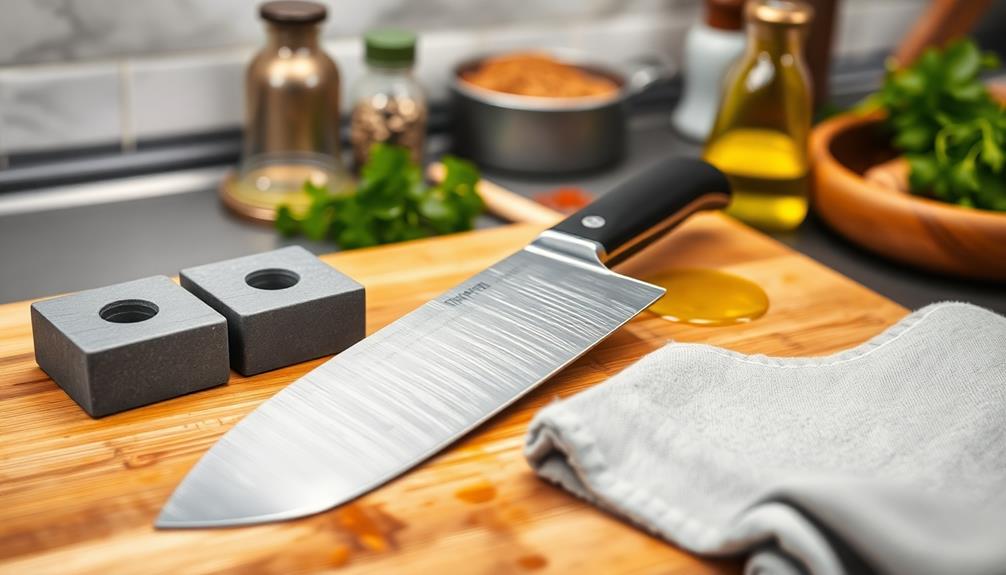
Regularly caring for your knives can greatly extend their lifespan and maintain peak performance. Start by inspecting the knife edges under light to spot any micro-chipping or dullness. Depending on how often you use them, sharpen your knives 1-2 times a year, or monthly if you're a heavy user. For a fun gathering, consider serving themed dishes like Graveyard Taco Dip to complement your culinary skills.
After each use, clean and dry your knives immediately to prevent corrosion; moisture can lead to rust, which notably reduces the blade's lifespan. Using honing steel before each use makes it much easier to maintain the knife's edge, prolonging sharpness between sharpenings.
Proper storage is also essential. Store your knives in a knife block, on a magnetic strip, or in sheaths to avoid dulling and accidental damage, ensuring both safety and longevity.
Finally, educate yourself on proper sharpening techniques tailored to your knife types. Understanding the right angle and method—whether manual, electric, or whetstone—can enhance performance and efficiency.
Understanding Knife Grip and Cutting Techniques
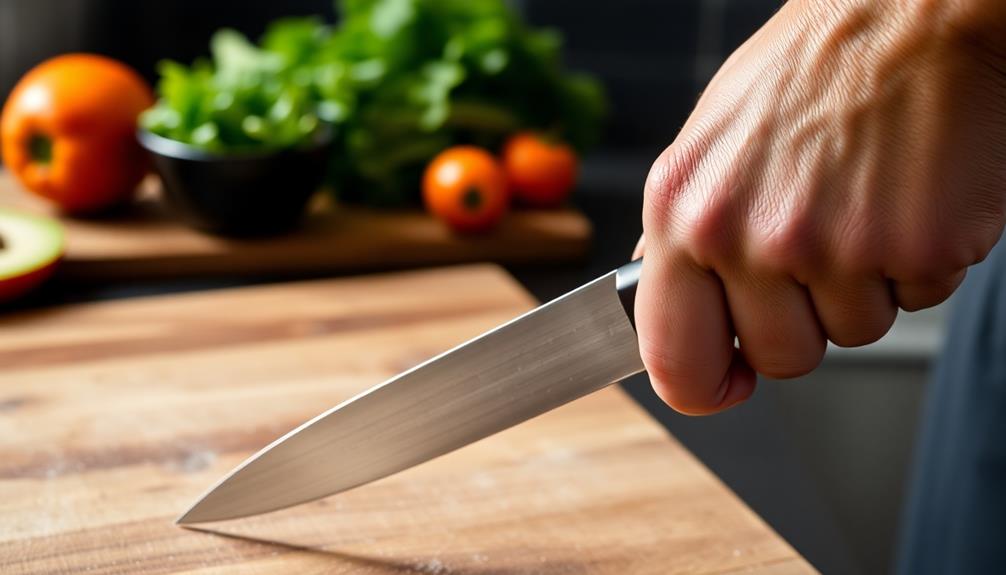
Understanding proper knife grip and cutting techniques is essential for anyone looking to enhance their culinary skills. A correct knife grip involves pinching the blade near the handle with your index finger and thumb, while your remaining fingers wrap around the handle. This grip enhances stability and control, allowing for greater precision during cutting tasks.
Additionally, mastering these techniques can be particularly helpful when preparing dishes like Mushroom Masala, where fine chopping of ingredients is vital for flavor integration.
When chopping, use the claw grip—curl your fingers under to protect them. This technique also lets your middle finger knuckle serve as a guide for cut thickness, ensuring safety. For slicing delicate items like herbs and garlic, employ a rocking motion with a European-style chef knife, keeping the tip on the cutting board for better control and efficiency.
Moreover, always consider the grain direction in cooked meat. Slicing against the grain yields more tender cuts, making them easier to chew.
Frequently Asked Questions
How Do Chefs Get Their Knives so Sharp?
Chefs get their knives sharp by regularly honing and sharpening them with precision. They use the right angle, practice consistent techniques, and choose high-quality materials, ensuring their tools maintain peak performance for various cutting tasks.
What Do Professionals Use to Sharpen Their Knives?
Professionals use whetstones, electric sharpeners, and honing steels to keep their knives sharp. While some might think it's complicated, these tools help you achieve precision and maintain your blades effortlessly, enhancing your cooking experience.
How to Professionally Sharpen Knives at Home?
To sharpen knives professionally at home, choose your tool wisely, whether it's a whetstone or electric sharpener. Follow instructions, maintain the right angle, and regularly check for dullness to keep your blades efficient.
What Does Gordon Ramsay Use to Sharpen His Knives?
Imagine sculpting a masterpiece; precision matters. Gordon Ramsay sharpens his knives using a whetstone, focusing on a consistent 18-degree angle, blending coarse and fine grits to achieve that perfect edge. Don't forget honing steel for maintenance!
Conclusion
By mastering knife sharpening, you'll not only improve your culinary skills but also extend the life of your tools. Remember, "a dull knife is more dangerous than a sharp one." So, keep those edges keen with the right tools and techniques. Regular maintenance and understanding your knives will make all the difference in your kitchen. With a little practice, you'll be slicing like a pro in no time. Happy cooking!
